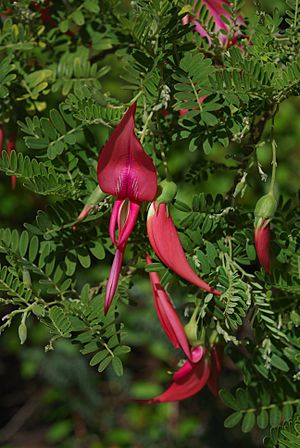Kakabeak facts for kids
Quick facts for kids Kakabeak |
|
|---|---|
 |
|
| Kakabeak leaves and flowers | |
| Scientific classification |
|
| Kingdom: | Plantae |
| Clade: | Tracheophytes |
| Clade: | Angiosperms |
| Clade: | Eudicots |
| Clade: | Rosids |
| Order: | Fabales |
| Family: | Fabaceae |
| Subfamily: | Faboideae |
| Tribe: | Galegeae |
| Subtribe: | Astragalinae |
| Genus: | Clianthus Sol. ex Lindl. 1835 |
| Type species | |
| Clianthus puniceus (G. Don) Sol. ex Lindl.
|
|
| Species | |
| Synonyms | |
|
|
The Kakabeak (also called kōwhai ngutukākā in Māori) is a special type of flowering plant that grows in New Zealand. It belongs to the legume family, which includes peas and beans. This plant gets its name from its bright red flowers, which look a lot like the beak of the kaka, a native New Zealand parrot. People also call it "parrot's beak," "parrot's bill," or "lobster claw" because of its unique flower shape.
There are two main types, or species, of Kakabeak. One has white or creamy flowers, called "Albus." Another has rosy pink flowers, known as "Roseus."
Contents
About the Kakabeak Plant
The Kakabeak plant usually grows to about two metres (around 6.5 feet) tall. It has branches that spread out. Its leaf stalks can be up to 15 centimetres (about 6 inches) long. These stalks hold several pairs of small leaflets.
Kakabeak plants usually flower from spring to early summer. However, they can sometimes flower twice a year. Some even have flowers all year round!
Where Does Kakabeak Grow?
There are two main species of Kakabeak. One is Clianthus puniceus, which is very rare. It is now only found in the wild on Moturemu Island in the Kaipara Harbour.
The other species is Clianthus maximus. This one is also rare, but not as critically endangered. In a survey done in 2005, only 153 C. maximus plants were found in the wild. Most of these were in the East Cape area of New Zealand. This number was much lower than in 1996, when over 1000 plants were counted.
Even though C. maximus is rare in the wild, it is often grown in gardens across New Zealand. However, most of these garden plants come from only a few original plants. This means they do not have much genetic variety. C. puniceus is also grown in gardens and has led to some award-winning types of plants called cultivars.
History and Discovery
The Kakabeak plant has an interesting history of discovery and naming. Joseph Banks and Daniel Solander were the first to collect samples of Clianthus in 1769. The species C. puniceus was officially described in 1835.
Later, William Colenso identified two different species of Clianthus as early as 1847. He described C. maximus in 1885. However, another botanist, Thomas Kirk, decided in 1899 that C. maximus was just a type of C. puniceus.
It wasn't until 2000 that Peter Heenan confirmed that C. maximus was indeed its own separate species again.
Family Tree of Plants
Clianthus is closely related to another New Zealand plant called Carmichaelia, which is also known as New Zealand broom. These two plants together are part of a larger group. This group also includes the Australian plant Swainsona and the New Zealand Montigena (scree pea).
One famous plant, Sturt's desert pea, looks a bit like Kakabeak. It was even first thought to be in the Clianthus family. Another group of New Zealand native legumes is Sophora, which includes eight species of kowhai trees.
Kakabeak on Stamps
The Kakabeak plant was featured on New Zealand's official stamps for many years. It appeared on stamps from 1960 to 1969.
First, it was on the 2d stamp before New Zealand switched to decimal currency. Then, from 1967, it was on the new 2c stamp.
Gallery
See also
 In Spanish: Clianthus para niños
In Spanish: Clianthus para niños



